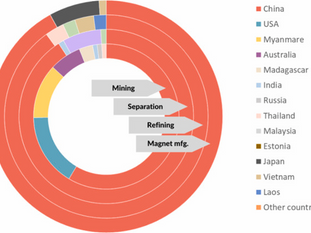In a previous article, we explained why recycling REPMs would be a strategic choice. However, it is easier said than done. Currently, about 1% of REPMs are recycled throughout the world. It is due to material, technical, economic and regulatory constraints.
Let’s start at the very beginning. REPMs are embedded in a variety of products, ranging from consumer electronics to wind turbines.
It means:
Heterogeneity in magnet shapes, proportions, and composition.
Heterogeneity in waste flows, as they depend on the lifespan of the products – which ranges from 1-2 years to 20 years (wind turbines).
It makes reproducible and scalable recycling infrastructures and supply chains difficult to implement. Not all methods fit all magnet types.
Then, there are technical constraints in concretely collecting and separating the magnet from its original product: this is mostly due to design choices. Magnets are often embedded deep within the products, glued, or designed with no consideration for disassembly. It entails time-consuming and costly manual labor to be able to extract the magnet, for small electronics as well as bigger products such as EVs or wind turbines, which require special dismantling methods.
Economic constraints refer to the fact that recycling magnets is more expensive than buying virgin magnets. It is due to:
Costly manual dismantling (as seen above)
Low concentration of REEs in devices
Competition from cheaper virgin magnets
Price volatility of REEs
Lack of structured market for recycled REPMs
(Illegal) trading - an uncomfortable obstacle :
A final constraint, often overlooked, is the illegal trading of e-waste, which constitutes a loss of REPMs. They are embedded within consumer electronics, hard drives, speakers, etc. which are Electronic and Electrical Equipment (EEE). When they are used and without intent of reuse, they become waste (WEEE, e-waste) and must be processed.
Cultural and legal asymmetries between the Global North and the Global South countries led to heightened environmental awareness, stricter environmental regulations and higher end-of-life treatment costs in the Global North, which led actors involved in EEE to seek cheap disposal options. And there are – but they are not legal. Uncontrolled, undocumented hazardous waste flows, including e-waste, from the Global North to the Global South were uncovered in the 1980s and have been continuing ever since. In the case of e-waste, the main driver is the recovery of valuable metals and materials, mostly iron, copper and aluminum.

The main facilitator of these waste flows remains the regulatory gap of the Basel Convention. Signed in 1989, it is the main international convention regulating transboundary movements of hazardous flows. However, it allows the movement of “used EEE” without any specific requirements. E-waste is thus smuggled as “used EEE” to avoid liability.
In 2022, 3,3 billion kg of e-waste were illegally moved across boundaries, 16 billion kg of e-waste were collected outside of formal schemes in high and middle-income countries, and 18 billion kg of e-waste were treated by the informal sector in middle and low-income countries. It leads to serious environmental and health hazards, as well as valuable materials loss. Even if REPMs are not the primary target of these illegal movements, they are still lost in the flows. Informal recyclers do not have the necessary technologies and infrastructures to properly collect and separate the magnets from their original product. 7 million kg of neodymium were present in the 62 billion kg of e-waste in 2022.

Conclusion
In sum, even if recycling REPMs is a logical and strategic choice, it remains hindered by material, technical, economic and regulatory constraints. It cannot substitute for broader efforts to secure and diversify primary REPMs supply.
Next we will talk about Terraquota's involvement in this field, next to actors working towards addressing some of the aforementioned issues in the Global South.
Author : Diane Naffah (in preparation of her Master's Thesis)
Reviewer : Hélène Trehin Isermeyer
The exhasutive list of sources is available on demand. They include reference to UNITAR Global E-waste Monitor Report, Articles from ScienceDirect, Data from Interpol.






